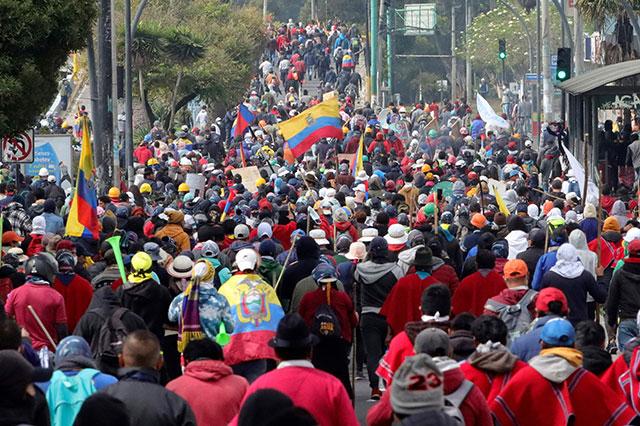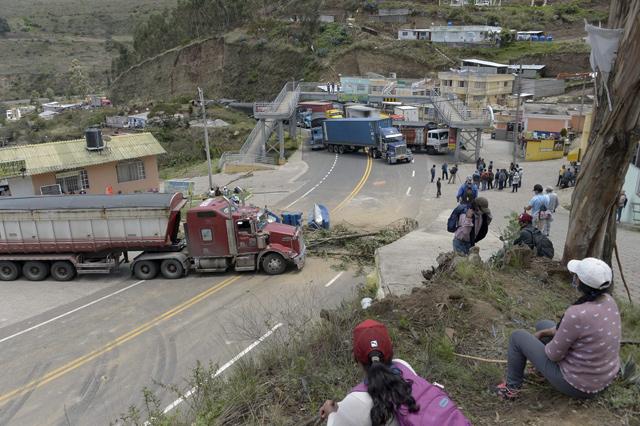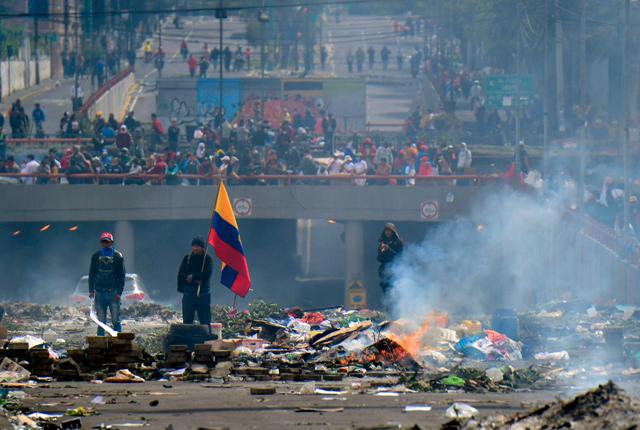You are here
Ecuadoran Indigenous protester dies in anti-government demos
By AFP - Jun 22,2022 - Last updated at Jun 22,2022

Indigenous people march towards the Central University of Ecuador in Quito, on Wednesday (AFP photo)
QUITO — An Indigenous protester died on Tuesday in clashes with law enforcement during a ninth day of demonstrations against the Ecuadorian government that the military has described as a “grave threat”.
An estimated 10,000 Indigenous people, many of whom traveled to Quito on foot or on the backs of trucks, took to the streets of the capital wielding sticks, fireworks and shields made from road signs, angry at fuel prices and President Guillermo Lasso’s conservative government.
The biggest clashes were concentrated in the north of the capital Quito, a city of more than two million, where officers, including some on motorcycles and horseback, attempted to disperse the crowds using anti-riot vehicles equipped with tear gas and water cannons.
The city’s cultural centre, a building surrounded by mirrors that has been a traditional meeting point for Indigenous people, was taken over by law enforcement on Sunday as they tried to control the crowds.
“Today’s objective is to retake the Casa de la Cultura,” protester Wilson Mazabanda told AFP before police used pepper spray to break up the group.
Several hours south of Quito, in the Amazon town of Puyo, a member of the Quichua Indigenous group was killed while participating in a roadblock when he was “hit in the face, apparently with a tear gas bomb” during a confrontation with law enforcement, lawyer Lina Maria Espinosa of the Alliance for Human Rights organisation told AFP.
Police, however, said “it was presumed that the person died as a result of handling an explosive device.”
His death followed that of a young man who earlier this week fell into a ravine in a town on the outskirts of Quito where protests were taking place. The prosecutor’s office has opened a homicide investigation into the incident, which police have declared an accident.
Amid the violence, President Lasso agreed to participate “for the good of the country” in a “frank and respectful dialogue process” with the powerful Confederation of Indigenous Nationalities of Ecuador (Conaie), which called the protests.
Its leader, Leonidas Iza, however, conditioned any talks on a repeal of the state of emergency that had been called in six of Ecuador’s 24 provinces, allowing the military to mobilise.
In a statement broadcast on social media, the Indigenous leader said the government’s response to the protests “has only managed to exacerbate the spirit of the population and generate serious escalations of conflict”.
The Alliance for Human Rights reported that at least 90 people have been injured and 87 detained since the start of the protests on June 13.
The police, for their part, have reported 101 uniformed personnel including soldiers injured, another 27 held by protesters and 80 protesters arrested.
Earlier in the day, Defence Minister Luis Lara said Ecuador’s democracy “faces a grave threat from... people who are preventing the free movement of the majority of Ecuadorans” with widespread blockades.
Flanked by the heads of the army, navy and air force, Lara warned the military “will not allow attempts to break the constitutional order or any action against democracy and the laws of the republic”.
Quito Mayor Santiago Guarderas said on Twitter the demonstrations “continue to escalate” and that the capital’s markets were running out of supplies.
‘Tired of this government’
Conaie — credited with helping topple three presidents between 1997 and 2005 — called for the demonstrations as Ecuadorans increasingly struggle to make ends meet.
Indigenous people comprise more than a million of Ecuador’s 17.7 million inhabitants and wield much political clout, but are disproportionately affected by rising inflation, unemployment and poverty exacerbated by the coronavirus pandemic.
“We are already tired of this government,” Mazabanda, a university student, said of ex-banker Lasso’s one-year-old term.
Tito Zamora, a small-scale farmer, added that costs have risen sharply, “but not the price we get for our products”.
Fuel prices have risen steeply since 2020, almost doubling for diesel from $1 to $1.90 per gallon and rising from $1.75 to $2.55 for gasoline.
Conaie is demanding a price cut to $1.5 a gallon for diesel and $2.1 for gasoline.
It also wants jobs and food price controls.
The movement has been joined by students, workers and other Ecuadorans feeling the economic pinch.
Ecuador is losing about $50 million a day as a result of the protests, without counting oil production — the country’s main export product.
The CEO of state-owned Petroecuador, Italo Cedeno, said on Tuesday output had dropped by about 100,000 barrels a day during the protests, in part because demonstrators have targeted both oil wells and power plants.
In 2019, Conaie-led protests left 11 people dead and more than 1,000 injured but forced then-president Lenin Moreno to abandon plans to eliminate fuel subsidies.
Related Articles
QUITO — Indigenous and rural Ecuadorans blocked roads in several provinces on Wednesday on the second day of protests against soaring fuel p
QUITO — Quito is a city beleaguered — its shops shuttered and streets empty of all but thousands of Indigenous protesters clamoring fo
QUITO — A first meeting between Ecuador’s president and indigenous leaders will take place on Sunday, the United Nations said, after Le


















